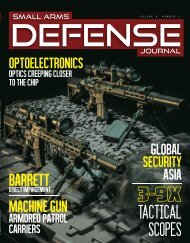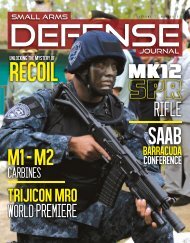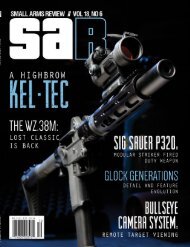SAR 20#2
Create successful ePaper yourself
Turn your PDF publications into a flip-book with our unique Google optimized e-Paper software.
should expect to find all (non-stainless) gun barrels and<br />
receivers to be made of an alloy steel; nickel-steel, nickel-chrome,<br />
or chrome-moly steel. These types of steel<br />
contain trace amounts- usually only up to 3% by mass<br />
of these other elements. The presence of nickel imparts<br />
extra strength and tremendous resistance to temperature<br />
and mechanical stresses. It is interesting to note that iron<br />
meteorites are usually an iron-nickel alloy- containing up<br />
to 25% nickel. That high nickel content is responsible<br />
for the meteorite’s ability to survive entry. The presence<br />
of chrome and molybdenum in steel alloy will increase<br />
hardness and resilience. Plain carbon steel is too weak<br />
and brittle or soft for firearms application. Chrome moly<br />
steels are not resistant to oxidation and other surface<br />
reactions to include rust and corrosion. Gun parts commercially<br />
produced from chrome moly steel are always<br />
encountered with a coating or treatment to inhibit surface<br />
corrosion. The most common are blueing and parkerizing<br />
which form protective oxide barriers on the steel. Chrome<br />
moly steel may be coated, clad, or plated in other metals<br />
like electroless nickel, hard chrome or newer high performance<br />
metal/polymer matrix coatings.<br />
Chrome moly steel is indeed the first choice of the<br />
professional market. It is tough. It maintains strength and<br />
stability over a wide temperature range. It resists fatigue<br />
and failure caused by abrasion, wear and heat. Even in<br />
hostile maritime environments, today’s material science<br />
offers a host of treatments and coatings to protect the<br />
steel from surface attack. Chrome moly used in ordnance<br />
is not a “free machining alloy”, that is, it is difficult to machine<br />
and form. However, chrome moly does lend itself<br />
well to the application of these aforementioned coatings<br />
and surface treatments. We are all familiar with “chromelined”<br />
barrels. Most all gun barrels in general circulation<br />
with our armed forces- pistol and rifle alike are chrome<br />
lined (M-16 rifle, M9 sidearm). Adding a layer of abrasion<br />
and heat resistant hard chrome to the interior surface<br />
of a barrel adds longevity. In the case of the M16 or<br />
AR-15, if it is respected and not abused, a chrome-lined,<br />
chrome-moly steel barrel can expect to serve its owner<br />
with good function and acceptable accuracy up to or beyond<br />
twenty thousand rounds.<br />
Stainless steel is rapidly becoming the default material<br />
used by barrel manufacturers. The most common alloy<br />
used in the gun market is known as 416R. This stainless<br />
steel makes an attractive barrel to be sure. It’s bright and<br />
shiny, and is known for being easy to machine. 416R is a<br />
“free machining alloy” which implies that it is created with<br />
a molecular structure that makes the material easy to cut.<br />
Free machining alloys employ trace amounts of lead and<br />
sulfur to improve machinability. While making this steel<br />
cost effective to manufacturers, and visually attractive<br />
to the consumer, the mechanical properties of free-machining<br />
alloy may also make it less desirable to the<br />
well-informed. 416R is not nearly as abrasion resistant<br />
as chrome-moly steel. And it can only claim 65,000 psi<br />
tensile strength (4140CM boasts 98,000psi). 416R does<br />
not resist fatigue and erosion from exposure to high heat.<br />
WWW.SMALLARMSREVIEW.COM 83 <strong>SAR</strong> Vol. 20, No. 2









